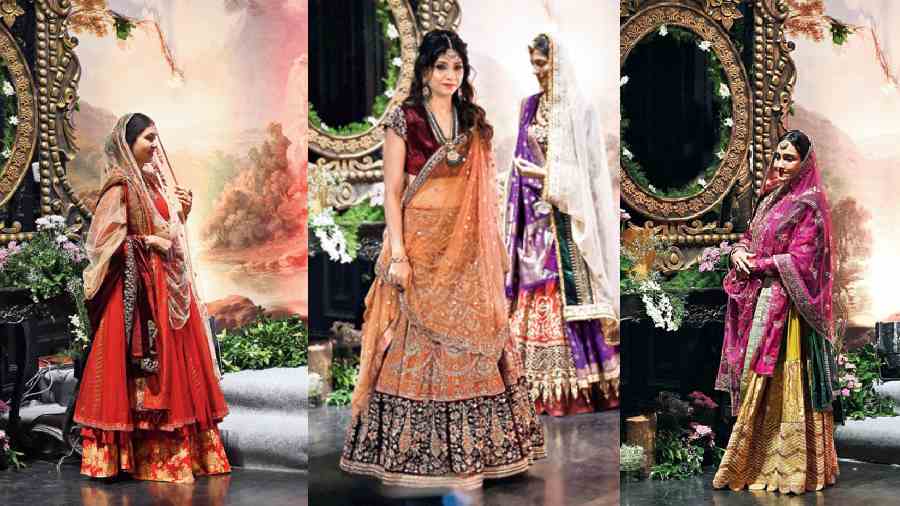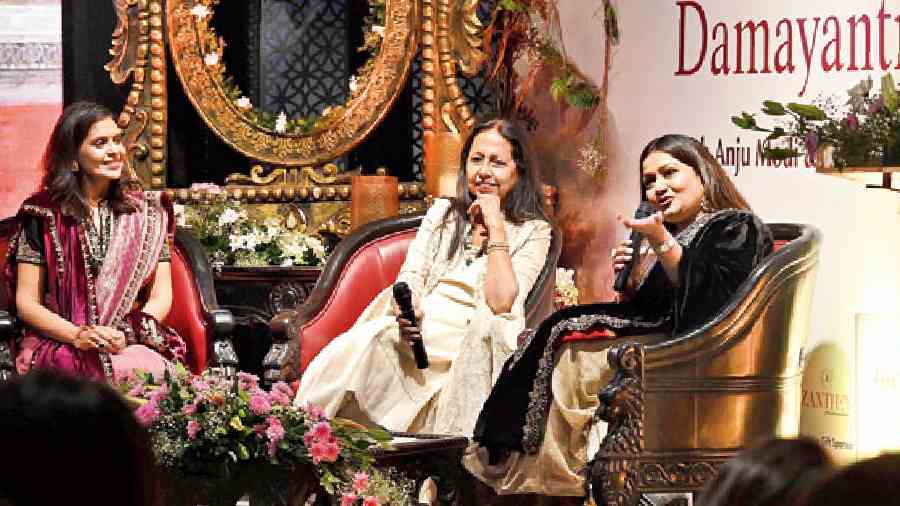Designer Anju Modi recently visited Kolkata for a special showcase of her collections, including her latest ‘Damayanti’ — inspired by Raja Ravi Varma’s paintings— at FICCI Flo Kolkata’s ‘Out of the Frames Damayanti: A Nostalgic Future’, at Galleria 1910 on November 11. She was joined by Dolly Jain and the conversation was moderated by FICCI Flo chairperson Shradha Saraf. The two spoke about their extensive travelling experience, love for saris and exploring ways to drape it. Sustainability and slow fashion were also discussed. The evening also witnessed a fashion show of Modi’s beautiful creations.
Highlights
SARI SAGA:
Dolly Jain: I wasn’t fond of pre-stitched saris at all and that is how this journey started. Till today, I wear my grandmother’s saris that are kept so well. It is about reusing the sari in so many different ways. My daughter, my mother-in-law and I wear the same sari with different drapes. Sari promotes slow fashion. Also, these days people don’t feel like repeating their clothes. You just need to change the drape and no one will say you are wearing the same sari. If you can give your saris to some second-hand store, people can buy it or rent it if it is kept in the right condition. Somewhere we have to keep in mind to limit ourselves. Buy something sensible that you will enjoy lifelong. If we have three generations, we drape differently. The granny feels comfortable with a little less drama, the bride’s mother a little more and the bride completely dramatic.
TO TREND OR NOT:
Anju Modi: I don’t believe in trends. Trends come and go. You create your own style. Wherever there is a trend, you incorporate it but have your own style. Be yourself and be confident in your own style. The designers express their creativity, their ideas. Some people carry something better than others.
TRAVEL TALES:
Anju Modi: Yes, my travels have influenced my work very much because I start any collection with a storytelling. I did ‘Draupadi’ and then the collection called ‘Devi’ on Bengal literature. It allows me to study and go deeper into the genre, and because of this passion of studying, it has given me these opportunities in the film industry. My travelling has helped me with my latest collection that I just showed in Delhi called ‘The Road Less Travelled’. I take the road which is not easily taken. Nowadays, people are travelling very often. If not once a week, at least once a month. You experience such different cultures. Instead of going to luxurious places, if you see the local lifestyle, see their love and affection.... There is an inspirational quote ‘travel far enough, you meet yourself’ and this inspired me very much. This is from my 30 years’ journey of going around. At a drop of a hat I am ready to travel. Rather than going to Paris, I am ready to go to any village.
Dolly Jain: During the wedding season, I travel almost 25 days a month. It is the family that supports me. I never feel low about travelling because it is my passion that takes me places. Every two days or three days, I have a new bride, a new family to meet. It may be the same drape that I am doing on two brides but I am excited. It is only passion that helps me to do this and achieve my goals. I don’t even know what jet lag is. Travelling to Met Gala and Cannes were like the benchmarks. I tell myself that is where I want to be even if it is a small thing like sari draping. When I started, people said Dolly is mad. Probably being mad takes one to Cannes and Met Gala! I met Sabya (Sabyasachi Mukherjee) and he said this is what you have to do. It was a corset where the sari had to fit in. I stitched and I like doing a lot of stitching.
Every time I do a drape and it is posted on Instagram, for 10 minutes I want to close my eyes because I don’t know how the audience will react to it. And finally, when it is posted and then we start reading the comments, we know we did a great job. Same thing for Deepika (Padukone) at Cannes. There was a white sari that we had to drape. Every time someone gives me a piece of garment, it is like a challenge for me that I have to do it in a new way. I am coming up with my coffee-table book on 365 plus one styles of draping a sari. I did not even leave out the leap year.(Laughs) There are so many different ways to wear a sari these days.
My work has spoken for itself. I have never publicised my work. I did not know the term sari draper. When I used to go for work, people used to say a sariwali has come. From that sariwali to a sari draper to a drape artist and today to be addressed as a drapeprenuer, it is a journey that only your passion can give you.

Glimpses from the show. The ladies of FICCI Flo walked the ramp in outfits from ‘Damayanti’ and costumes from Bajirao Mastani and Ram Leela, that were designed by Anju Modi. The looks were complemented with jewellery from Chirag Jewellers. “In my younger days, I used to sketch a lot of Raja Ravi Varma paintings and was so much inspired by the looks and colour combination. There is something very beautiful about them and the nature depicted in them. So, when I got an opportunity to make this collection it was very rewarding for me,” said Anju Modi about ‘Damayanti’.
Sustainability and couture:
Anju Modi: Couture has been in our country for many years. Whether it is ikat, patola or bandhani, making these are very time-consuming. Couture is custom-made and one-of-a-kind. Slow fashion comes from there only. It is very much like meditation. So, slow fashion and couture goes hand in hand. Two hundred hours of human work cannot be compared with 20 hours of machine work. We have to appreciate the human labour. It is a two-fold process. We are maintaining the Indian traditional craft and at the same time we are sustaining the family depending on it.
‘Damayanti’:
Anju Modi: Damayanti is the famous muse of Raja Ravi Varma paintings and I call it a nostalgic romance, which takes us back in those days. Luckily, for me, I got this opportunity to do this work. I got this very fine fabric called Tencel. They approached me and they asked me to do a collection with their fabric. It is made out of biodegradable fibre and it has a beautiful drape. lt is made out of wood pulp. It aligned with my thoughts. They wanted to promote saris, so then I thought of Raja Ravi Varma. It was my honour to pay my tribute to him.
The Telegraph talks...
“When I started doing the collection Damayanti, I noticed they are all Maharashtrian drapes. I taught my entire team to drape the sari in dhoti style. It was a learning experience but at the same time challenging and rewarding. Sari is a drape fabric. So how you drape it is important. It is making your own physical look more aesthetic and more appealing and at the same time it is comfortable. You don’t feel cumbersome. You can spend a whole 24 hours in it. In fact in our younger days, we used to sleep in saris when we had to wear saris everyday and still look fresh after waking up,” Anju Modi to The Telegraph in a post-show chat. Her favourite drapes? “The Maharashtrian way of draping dhoti sari, a nine-yard sari drape. Secondly, I love wearing a two-piece sari, like a mekhla and take a drape around in it,” she said.
Winter wedding draping tips from drapepreneur Dolly Jain:
- Buy a velvet shawl and add drama to your sari drape with it.
- Buy beautiful jackets and team your drapes with the jacket. Light fabrics also go well with jacket looks.
- Incorporate stoles and use fabrics like ikat to support weavers and give a traditional Indian look to your style
